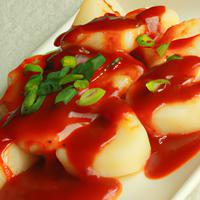
1 serving (150 grams) contains 200 calories, 4.0 grams of protein, 1.5 grams of fat, and 45.0 grams of carbohydrates.

Log this food in SnapCalorie

Nutrition Information
Calories |
317.5 | ||
|---|---|---|---|
% Daily Value* |
|||
| Total Fat | 2.4 g | 3% | |
| Saturated Fat | 0.3 g | 1% | |
| Polyunsaturated Fat | 0 g | ||
| Cholesterol | 0 mg | 0% | |
| Sodium | 793.7 mg | 34% | |
| Total Carbohydrates | 71.4 g | 25% | |
| Dietary Fiber | 1.6 g | 5% | |
| Sugars | 7.9 g | ||
| protein | 6.3 g | 12% | |
| Vitamin D | 0 mcg | 0% | |
| Calcium | 31.7 mg | 2% | |
| Iron | 0.8 mg | 4% | |
| Potassium | 79.4 mg | 1% | |
* Percent Daily Values are based on a 2,000 calorie diet. Your daily values may be higher or lower depending on your calorie needs.
Food Attributes
Source of Calories
About Rice cakes with sauce
Rice cakes with sauce are a versatile dish originating from East Asian cuisines, particularly Korea and China. Korean tteokbokki features chewy rice cakes drenched in a spicy-sweet gochujang-based sauce, while Chinese versions may include soy sauce blends and savory toppings. These rice cakes are typically made from glutinous rice flour, rendering them naturally gluten-free and a good source of energy due to their carbohydrate content. The sauce contributes bold flavors, often including chili, garlic, and soy for depth. While rice cakes themselves are low in fat, sauces can vary in healthfulness, depending on sugar and sodium levels. Adding vegetables or lean proteins can enhance the nutritional value of this dish. Perfect for sharing or enjoying solo, rice cakes with sauce emphasize comfort and flavor, making them a beloved street food and snack in their region of origin and beyond.



